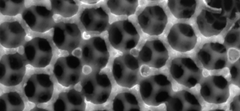Wednesday, 09 December, 2015
Customized hybrids
New high-tech material
Munich researchers have designed extremely thin and exceedingly robust, yet highly porous semiconductor layers that show great promise for use in light-weight, flexible solar cells, for example, or as superior electrodes to improve the performance of rechargeable batteries.
The coating on the wafer shimmers like an opal – and it has amazing properties: It is remarkably hard, exceptionally thin and – since it is highly porous – light as a feather.
By integrating suitable organic polymers into the pores of the material, the scientists led by Dr. Dina Fattakhova-Rohlfing, PD at the LMU, and Professor Thomas Fässler, Chair of Inorganic Chemistry with a Focus on New Materials at TU Munich, can customize the electrical properties of the ensuing hybrid material for different applications. The design not only saves space, but also creates large interfacial surfaces that improve overall effectiveness.
“Our raw material can be thought of as a porous scaffold with a structure akin to a honeycomb. The walls comprise inorganic, semiconducting germanium, which can produce and store electric charges. Since the honeycomb’s walls are extremely thin, charges can flow along short paths,” explains Fässler.
A new design approach
However, to transform the stiff but brittle germanium into a flexible and porous layer the researchers had to use a few tricks. Traditionally, etching processes are used to structure the surface of germanium. However, this approach is difficult to control on an atomic level. The new procedure solves this problem.
Together with his team, Fässler established a method of synthesis that allows one to fabricate the desired structures very precisely and reproducibly. The raw material is a soluble form of germanium with its atoms arranged in clusters of nine. Since these clusters are electrically charged, they repel each other in solution. Network formation takes place between them only when the solvent is evaporated.
This can be easily achieved by exposing the solution to a temperature of 500 °C but cross-linking of clusters can also be chemically induced, by adding germanium chloride, for example. By using other chlorides, such as phosphorus chloride, the germanium structures can then be easily doped. This allows the researchers to directly adjust the properties of the resulting nanomaterials in a readily controllable manner.
Tiny synthetic beads as nanotemplates
To give the germanium clusters the desired porous structure, Fattakhova-Rohlfing has developed a methodology to enable nanostructuring, in which tiny polymer beads are used to form three-dimensional templates in the initial step.
In the next step, the germanium clusters in solution fill the gaps between the beads. As soon as stable germanium networks have formed on the surface of the beads, the templates are removed by applying heat. What remains is the highly porous nanofilm.
The polymer beads used in this procedure have a diameter of 50 to 200 nanometers and form a three-dimensional opaline structure. The germanium scaffold that emerges on the surface acts as a negative mold – so that an inverse opaline structure is formed. Thus, the nanolayers shimmer like an opal.
“The porous germanium itself has unique optical and electrical properties that are useful for many energy-relevant applications,” says Fattakhova-Rohlfing, who developed the material in collaboration with Fässler. “Beyond that, we can fill the pores with a wide variety of functional materials, thereby creating a broad range of novel hybrid materials.”
Nanolayers pave the way to new portable photovoltaics and battery systems
“When combined with polymers, porous germanium structures are suitable for the development of a new generation of stable, extremely light-weight and flexible solar cells that can charge mobile phones, cameras and laptops while on the road,” explains the physicist Peter Müller-Buschbaum, Professor of Functional Materials at TU Munich.
Manufacturers around the world are on the lookout for light-weight and robust materials for use in portable solar cells. To date they have used primarily organic compounds, which are sensitive and have relatively short lifetimes. Heat and light decompose the polymers and cause the performance to degrade. Here, the thin but robust germanium hybrid layers provide a real alternative.
Next, the researchers want to use the new technology to manufacture highly porous silicon layers. The layers are currently being tested as anodes for rechargeable batteries. They could conceivably replace the graphite layers currently in use for this purpose, yielding batteries with improved capacity.
The research was funded by the Solar Technologies Go Hybrid program of the Bavarian State Ministry of Economics, and carried out in the context of the Excellence Cluster Nanosystems Initiative Munich (NIM) and the Center for NanoSciences (CeNS), which are financed by the German Research Foundation (DFG). (TUM/LMU)
Angewandte Chemie 2015



 Press release LMU (German)
Press release LMU (German)